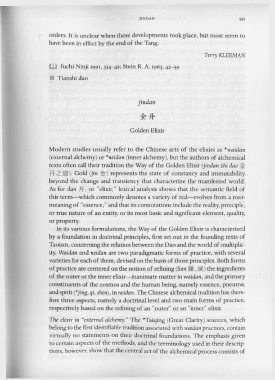Page 592 - The Encyclopedia of Taoism v1_A-L
P. 592
JINDAN 551
orders. It is unclear when these developments took place, but most seem to
have been in effect by the end of the Tang.
Terry KLEEMAN
m fuchi Ninji 1991, 334- 42; Stein R. A. 1963, 42-59
* Tianshi dao
jindan
Golden Elixir
Modern studies usually refer to the Chinese arts of the elixirs as *waidan
(external alchemy) or *neidan (inner alchemy), but the authors of alchemical
texts often call their tradition the Way of the Golden Elixir (jindan zhi dao ~
::Pt z.Jll). Gold (jin ~) represents the tate of constancy and irnmutability
beyond the change and transiency that characterize the manifested world.
As for dan ::Pt, or "elixir," lexical analysis shows that the semantic field of
this term-which commonly denotes a variety of red- evolves from a root-
meaning of "essence," and that its connotations include the reality, principle,
or true nature of an entity, or its most basic and significant element, quality,
or property.
In its various formulations, the Way of the Golden Elixir is characterized
by a foundation in doctrinal principles, first set out in the founding texts of
Taoism, concerning the relation between the Dao and the world of multiplic-
ity. Waidan and neidan are two paradigmatic forms of practice, with several
varieties for each of them, devised on the basis of those principles. Both forms
of practice are centered on the notion of refining (lian i*, 1:.*) the ingredients
of the outer or the inner elixir-inanimate matter in waidan, and the primary
constituents of the cosmos and the human being, namely essence, pneuma,
and spirit (*jing, qi, shen), in neidan. The Chinese alchemical tradition has there-
fore three aspects, namely a doctrinal level and two main forms of practice,
respectively based on the refining of an "outer" or an "inner" elixir.
The elixir in "external alchemy." The *Taiqing (Great Clarity) sources, which
belong to the first identifiable tradition associated with waidan practices, contain
virtually no statements on their doctrinal foundations. The emphasis given
to certain aspects of the methods, and the terminology used in their descrip-
tions, however, show that the central act of the alchemical process consists of

